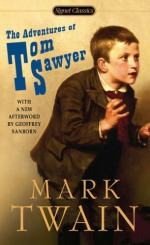|
This section contains 139 words (approx. 1 page at 400 words per page) |

|
The mid-nineteenth century produced a number of books dealing with boys rebelling against conventional society, such as Thomas Bailey Aldrich's Story of a Bad Boy (1869). While Twain's book is a powerful and original addition to literature about young people, it retains some of the "literary" language of nineteenth-century fiction.
Twain abandons these conventions in The Adventures of Huckleberry Finn, in which he permits the title character to tell the story.
The novel contains many qualities of the adventure story: villains menace the innocent, hide treasures in caves, and inhabit haunted houses; heroes rescue helpless victims, discover buried treasure, and gain recognition from the women they love and from their community. Twain also employs conventions of frontier literature, in which pranks disrupt the order of the church and school, and the ominous Native American seeks revenge.
|
This section contains 139 words (approx. 1 page at 400 words per page) |

|




